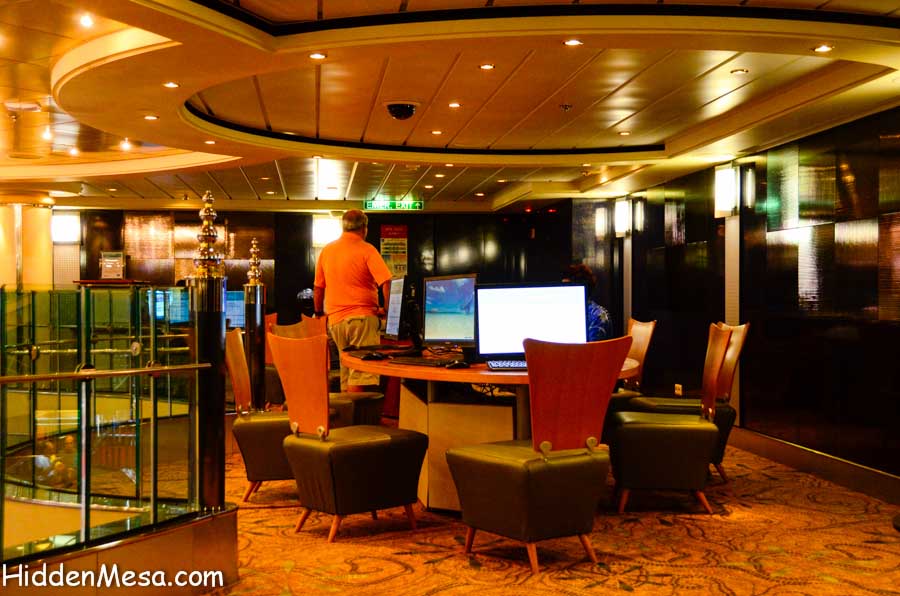One of the things we’ve quickly grown accustomed to in the 21st century is the ability to communicate with just about any person, any time. We’ve also grew used to the idea that whatever information we want is at our fingertips pretty much instantly. Our cell phones have more computing power than the computers that landed the Apollo capsules on the moon, and we take that for granted.
So how does all this work when we step aboard a ship and find ourselves at sea, sometimes for several days at a time? Do we lose the ability to communicate? To have instant access? Well, the answer is yes and no. All this is available, but the cost is sometimes more than you might want to spend.
The answer is that phone service is available in all sorts of ways. All it takes is a willingness to pay for it. From your state room, all that’s usually necessary on most cruise lines is to pick up the phone and dial the number you want. That usually involves an outside code, an international code for your country, and the local number. On Norwegian Cruise Lines, specifically the Norwegian Star, the price for a call to the US is $4.99 per minute. So if you really want to make a phone call, it’s available.
But what about from your cell phone? Making calls from your cell phone is entirely doable, but we haven’t spent much time planning or even researching this feature simply because of its expense. Our research mostly involved our primary carrier, which is Verizon. Verizon seems to have arrangements with all cruise lines, including Norwegian. To use it, all that’s needed is to add the service to your account before you leave. The reason we haven’t looked into it more thoroughly was because the prices seemed to average around $7.99 per minute. Too expensive when it’s not really necessary, especially when using the phone in the room is so much less expensive.
In checking with the front desk aboard the ship, it was explained to us that the “ship” actually had nothing to do with the cell phone service; that the signal was being managed by the cell phone companies. The ship would not bill us for the cell phone service. The charges would show up on our individual cell phone bills.
This doesn’t seem too far fetched. We were speaking with a customer service person with limited English, and apparently limited technical understanding. What she probably meant was that a cell phone company had installed cell phone equipment aboard the ship and was acting as a third party carrier, using satellite to link back to the major cell phone companies in our home country. That would also explain the fairly high prices.
In a nutshell, cell phone service seems to be available, but you probably should have a good reason to use it, considering the price.
But wait, there’s an even less expensive way to maintain telephone communications. We discovered on a cruise not too long ago – aboard the Royal Caribbean Liberty of the Sea – that we could make telephone calls using our internet connection and our Skype account. We maintain a Skype account that allows us to call any phone in the US for $2.99 (US) per month. We use it to make calls back to the US when we’re abroad and can find a WiFi connection. It turns out that when conditions are good aboard ship, their internet is good enough to use Skype too. This reduces the price of a phone call to around 55 cents per minute, depending on which internet package you buy. Still expensive, but way less than the cost of a regular phone call. We should point out that this method does not always work. If the internet is being heavily used aboard the ship, the connection may be too slow to work properly. When you encounter this, simply hang up and try again later. It’s a compromise you’ll need to consider in order to keep the costs down.
Internet aboard a ship is through a satellite connection. If you’ve ever had to align your own satellite dish, you’d be amazed that a satellite connection can be made from a ship rolling around in the ocean, but surprisingly, it can. It’s not cheap though, and it’s not the best speed you will ever find.
The first problem associated with a satellite connection is called latency. Latency in terms of internet connections is the amount of time it takes a signal to travel from your computer to the web site you’re communicating with. Normal latency is around 30 to 90 milliseconds (thousandths of a second). When a satellite connection gets involved, typical latency goes up to around 900 milliseconds or even higher. It can’t be helped. It’s physics because it is caused by the amount of time it takes a signal to travel from a geostationary satellite, 20,000 miles out in space, and back to earth again. Until we figure out how to make a radio signal travel faster than the speed of light, latency issues will always exist when using satellite communications.
The second problem is that there are a potential of literally several thousand people trying to use one satellite connection at a time. We all know how well that works. Even a good infrastructure can be taxed when too many people are trying to use it at the same time.
Having said that, internet connections aboard ships are generally pretty good. All ships we’ve been on lately have good WiFi connectivity all over the ship and their satellite systems are as good as they can be, considering that they’re satellites.
Prices vary. There’s usually a pay-per-use plan, then a couple of different plans based on the number of minutes you plan to use. On our current cruise, the prices are 75 cents per minute if you have no plan and pay as you go, 55 cents per minute if you want 100 minutes. The most economical plan is 250 minutes for $100.00 (US).
Of course, you forfeit any remaining minutes at the end of a cruise, so there’s no prorated adjustment.
There’s also an Internet Cafe on the ship where the cruise line has several computers set up If you didn’t bring your own. On the Norwegian Star, it’s located on Deck 8, mid ship. From there you can log into your account to get access to the internet, and go online to check email, or whatever.
It’s clear that we’re still in the frontier of connectivity where the cruise lines are concerned. The focus seems to be about the cruise and less about connectivity with home and the outside world. And when it’s all said and done, maybe that’s not such a bad thing.









